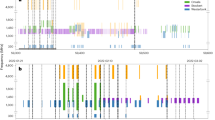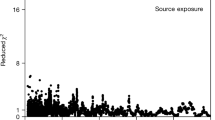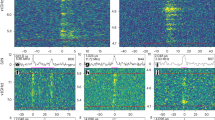Abstract
Fast radio bursts (FRBs) are highly dispersed millisecond-duration radio flashes probably arriving from far outside the Milky Way1,2. This phenomenon was discovered at radio frequencies near 1.4 gigahertz and so far has been observed in one case3 at as high as 8 gigahertz, but not at below 700 megahertz in spite of substantial searches at low frequencies4,5,6,7. Here we report detections of 13 FRBs at radio frequencies as low as 400 megahertz, on the Canadian Hydrogen Intensity Mapping Experiment (CHIME) using the CHIME/FRB instrument8. They were detected during a telescope pre-commissioning phase, when the sensitivity and field of view were not yet at design specifications. Emission in multiple events is seen down to 400 megahertz, the lowest radio frequency to which the telescope is sensitive. The FRBs show various temporal scattering behaviours, with the majority detectably scattered, and some apparently unscattered to within measurement uncertainty even at our lowest frequencies. Of the 13 reported here, one event has the lowest dispersion measure yet reported, implying that it is among the closest yet known, and another has shown multiple repeat bursts, as described in a companion paper9. The overall scattering properties of our sample suggest that FRBs as a class are preferentially located in environments that scatter radio waves more strongly than in the diffuse interstellar medium in the Milky Way.
This is a preview of subscription content, access via your institution
Access options
Access Nature and 54 other Nature Portfolio journals
Get Nature+, our best-value online-access subscription
$29.99 / 30 days
cancel any time
Subscribe to this journal
Receive 51 print issues and online access
$199.00 per year
only $3.90 per issue
Buy this article
- Purchase on Springer Link
- Instant access to full article PDF
Prices may be subject to local taxes which are calculated during checkout


Similar content being viewed by others
Data availability
The raw data used in this publication are available at https://chime-frb-open-data.github.io/.
References
Lorimer, D. R., Bailes, M., McLaughlin, M. A., Narkevic, D. J. & Crawford, F. A bright millisecond radio burst of extragalactic origin. Science 318, 777–780 (2007).
Thornton, D. et al. A population of fast radio bursts at cosmological distances. Science 341, 53–56 (2013).
Gajjar, V. et al. Highest frequency detection of FRB 121102 at 4–8 GHz using the breakthrough listen digital backend at the Green Bank Telescope. Astrophys. J. 863, 2 (2018).
Karastergiou, A. et al. Limits on fast radio bursts at 145 MHz with ARTEMIS, a real-time software backend. Mon. Not. R. Astron. Soc. 452, 1254–1262 (2015).
Rowlinson, A. et al. Limits on fast radio bursts and other transient sources at 182 MHz using the Murchison Widefield Array. Mon. Not. R. Astron. Soc. 458, 3506–3522 (2016).
Amiri, M. et al. Limits on the ultra-bright fast radio burst population from the CHIME pathfinder. Astrophys. J. 844, 161 (2017).
Chawla, P. et al. A search for fast radio bursts with the GBNCC pulsar survey. Astrophys. J. 844, 140 (2017).
The CHIME/FRB Collaboration et al. The CHIME fast radio burst project: system overview. Astrophys. J. 863, 48 (2018).
The CHIME/FRB Collaboration. A second source of repeating fast radio bursts. Nature 566, https://doi.org/10.1038/s41586-018-0864-x (2019).
Bandura, K. et al. ICE: A scalable, low-cost FPGA-based telescope signal processing and networking system. J. Astron. Instrum. 05, 1641005 (2016).
Denman, N. et al. A GPU-based correlator X-engine implemented on the CHIME pathfinder. Preprint at http://ArXiv.org/abs/1503.06202 (2015).
Champion, D. J. et al. Five new fast radio bursts from the HTRU high-latitude survey at Parkes: first evidence for two-component bursts. Mon. Not. R. Astron. Soc. 460, L30–L34 (2016).
Sokolowski, M. et al. No low-frequency emission from extremely bright fast radio bursts. Astrophys. J. Lett. 867, L12 (2018).
Macquart, J.-P. & Koay, J. Y. Temporal smearing of transient radio sources by the intergalactic medium. Astrophys. J. 776, 125 (2013).
Zhu, W., Feng, L.-L. & Zhang, F. The scattering of FRBs by the intergalactic medium: variations, strength, and dependence on dispersion measures. Astrophys. J. 865, 147 (2018).
Ravi, V. & Loeb, A. Explaining the statistical properties of fast radio bursts with suppressed low-frequency emission. Preprint at http://ArXiv.org/abs/1811.00109 (2018).
Cordes, J. M. & Lazio, T. J. W. NE2001. I. A new model for the galactic distribution of free electrons and its fluctuations. Preprint at http://ArXiv.org/abs/astro-ph/0207156 (2002).
Yao, J. M., Manchester, R. N. & Wang, N. A new electron-density model for estimation of pulsar and FRB distances. Astrophys. J. 835, 29 (2017).
McQuinn, M. Locating the “missing” baryons with extragalactic dispersion measure estimates. Astrophys. J. 780, L33 (2013).
Dolag, K., Gaensler, B. M., Beck, A. M. & Beck, M. C. Constraints on the distribution and energetics of fast radio bursts using cosmological hydrodynamic simulations. Mon. Not. R. Astron. Soc. 451, 4277–4289 (2015).
Anderson, L. D. et al. The WISE catalog of galactic H II regions. Astrophys. J. Suppl. Ser. 212, 1 (2014).
Avedisova, V. A catalog of star-forming regions in the galaxy. Astron. Rep. 46, 193–205 (2002).
Inoue, S. Probing the cosmic reionization history and local environment of gamma-ray bursts through radio dispersion. Mon. Not. R. Astron. Soc. 348, 999–1008 (2004).
Xu, S. & Zhang, B. On the origin of the scatter broadening of fast radio burst pulses and astrophysical implications. Astrophys. J. 832, 199 (2016).
Cordes, J. M., Wharton, R. S., Spitler, L. G., Chatterjee, S. & Wasserman, I. Radio wave propagation and the provenance of fast radio bursts. Preprint at http://ArXiv.org/abs/1605.05890 (2016).
Farah, W. et al. FRB microstructure revealed by the real-time detection of FRB170827. Mon. Not. R. Astron. Soc. 478, 1209–1217 (2018).
Connor, L., Sievers, J. & Pen, U.-L. Non-cosmological FRBs from young supernova remnant pulsars. Mon. Not. R. Astron. Soc. 458, L19–L23 (2016).
Kumar, P., Lu, W. & Bhattacharya, M. Fast radio burst source properties and curvature radiation model. Mon. Not. R. Astron. Soc. 468, 2726–2739 (2017).
Margalit, B. & Metzger, B. D. A concordance picture of FRB 121102 as a flaring magnetar embedded in a magnetized ion-electron wind nebula. Preprint at http://ArXiv.org/abs/1808.09969 (2018).
Pen, U.-L. & Levin, Y. Pulsar scintillations from corrugated reconnection sheets in the interstellar medium. Mon. Not. R. Astron. Soc. 442, 3338–3346 (2014).
Connor, L. et al. Constraints on the FRB rate at 700–900 MHz. Mon. Not. R. Astron. Soc. 460, 1054–1058 (2016).
Ravi, V. The observed properties of fast radio bursts. Mon. Not. R. Astron. Soc. 482, 1966–1978 (2019).
Ng, C. et al. CHIME FRB: An application of FFT beamforming for a radio telescope. Preprint at http://ArXiv.org/abs/1702.04728 (2017).
Newburgh, L. B. et al. Calibrating CHIME: a new radio interferometer to probe dark energy. Proc. SPIE 9145, 91454V (2014).
Thompson, A. R., Moran, J. M. & Swenson, G. W. Jr Interferometry and Synthesis in Radio Astronomy 3rd edn (Springer, Cham, 2017).
Taylor, J. H. A sensitive method for detecting dispersed radio emission. Astron. Astrophys. Suppl. 15, 367–369 (1974).
Cortes, C. & Vapnik, V. Support-vector networks. Mach. Learn. 20, 273–297 (1995).
Obrocka, M., Stappers, B. & Wilkinson, P. Localising fast radio bursts and other transients using interferometric arrays. Astron. Astrophys. 579, A69 (2015).
Petroff, E. et al. A fast radio burst with a low dispersion measure. Mon. Not. R. Astron. Soc. 482, 3109–3115 (2018).
Lorimer, D. R. & Kramer, M. Handbook of Pulsar Astronomy (Cambridge Univ. Press, Cambridge, 2012).
Goodman, J. & Weare, J. Ensemble samplers with affine invariance. Commun. Appl. Math. Comput. Sci. 5, 65–80 (2010).
Foreman-Mackey, D., Hogg, D. W., Lang, D. & Goodman, J. emcee: The MCMC Hammer. Publ. Astron. Soc. Pacif. 125, 306–312 (2013).
Bhandari, S. et al. The SUrvey for Pulsars and Extragalactic Radio Bursts – II. New FRB discoveries and their follow-up. Mon. Not. R. Astron. Soc. 475, 1427–1446 (2018).
Cordes, J. M. & McLaughlin, M. A. Searches for fast radio transients. Astrophys. J. 596, 1142–1154 (2003).
Ioka, K. The cosmic dispersion measure from gamma-ray burst afterglows: probing the reionization history and the burst environment. Astrophys. J. 598, L79–L82 (2003).
Cordes, J. M. & Lazio, T. J. W. NE2001. II. Using radio propagation data to construct a model for the galactic distribution of free electrons. http://xxx.lanl.gov/abs/astro-ph/0301598 (2003).
Lorimer, D. R. et al. The Parkes Multibeam Pulsar Survey – VI. Discovery and timing of 142 pulsars and a Galactic population analysis. Mon. Not. R. Astron. Soc. 372, 777–800 (2006).
Faucher-Giguère, C.-A. & Kaspi, V. M. Birth and evolution of isolated radio pulsars. Astrophys. J. 643, 332–355 (2006).
Vedantham, H. K. & Phinney, E. S. Radio wave scattering by circumgalactic cool gas clumps. Mon. Not. R. Astron. Soc. 483, 971–984 (2019).
Masui, K. et al. Dense magnetized plasma associated with a fast radio burst. Nature 528, 523–525 (2015).
Acknowledgements
We are grateful for the help we received from the Dominion Radio Astrophysical Observatory, operated by the National Research Council Canada. The CHIME/FRB Project is funded by a grant from the Canada Foundation for Innovation 2015 Innovation Fund (Project 33213), as well as by the Provinces of British Columbia and Québec, and by the Dunlap Institute for Astronomy and Astrophysics at the University of Toronto. Additional support was provided by the Canadian Institute for Advanced Research (CIFAR), McGill University and the McGill Space Institute via the Trottier Family Foundation, and the University of British Columbia. The Dunlap Institute is funded by an endowment established by the David Dunlap family and the University of Toronto. Research at Perimeter Institute is supported by the Government of Canada through Industry Canada and by the Province of Ontario through the Ministry of Research & Innovation. The National Radio Astronomy Observatory is a facility of the National Science Foundation operated under cooperative agreement by Associated Universities, Inc. P.C. is supported by an FRQNT Doctoral Research Award and a Mitacs Globalink Graduate Fellowship. M.D. acknowledges support from CIFAR, Natural Sciences and Engineering Research Council of Canada (NSERC) Discovery and Accelerator Grants, and from FRQNT Centre de Recherche en Astrophysique du Québec (CRAQ). B.M.G. acknowledges the support of the NSERC through grant RGPIN-2015-05948, and the Canada Research Chairs program. A.S.H. is partly supported by the Dunlap Institute. V.M.K. holds the Lorne Trottier Chair in Astrophysics & Cosmology and a Canada Research Chair and receives support from an NSERC Discovery Grant and Herzberg Award, from an R. Howard Webster Foundation Fellowship from CIFAR, and CRAQ. C.M. is supported by a NSERC Undergraduate Research Award. J.M.-P. is supported by the MIT Kavli Fellowship in Astrophysics and a FRQNT postdoctoral research scholarship. M.M. is supported by a NSERC Canada Graduate Scholarship. Z.P. is supported by a Schulich Graduate Fellowship. S.M.R. is a CIFAR Senior Fellow and is supported by the NSF Physics Frontiers Center award 1430284. P.S. is supported by a DRAO Covington Fellowship from the National Research Council Canada. FRB research at UBC is supported by an NSERC Discovery Grant and by CIFAR.
Author information
Authors and Affiliations
Consortia
Contributions
All authors on this paper played either leadership or significant supporting roles in one or more of the following: the management, development and construction of the CHIME telescope, the CHIME/FRB instrument and the CHIME/FRB software data pipeline, the commissioning and operations of the CHIME/FRB instrument, the data analysis and preparation of this manuscript.
Ethics declarations
Competing interests
The authors declare no competing interests.
Additional information
Publisher’s note: Springer Nature remains neutral with regard to jurisdictional claims in published maps and institutional affiliations.
Extended data
Rights and permissions
About this article
Cite this article
The CHIME/FRB Collaboration. Observations of fast radio bursts at frequencies down to 400 megahertz. Nature 566, 230–234 (2019). https://doi.org/10.1038/s41586-018-0867-7
Received:
Accepted:
Published:
Issue Date:
DOI: https://doi.org/10.1038/s41586-018-0867-7
Comments
By submitting a comment you agree to abide by our Terms and Community Guidelines. If you find something abusive or that does not comply with our terms or guidelines please flag it as inappropriate.



